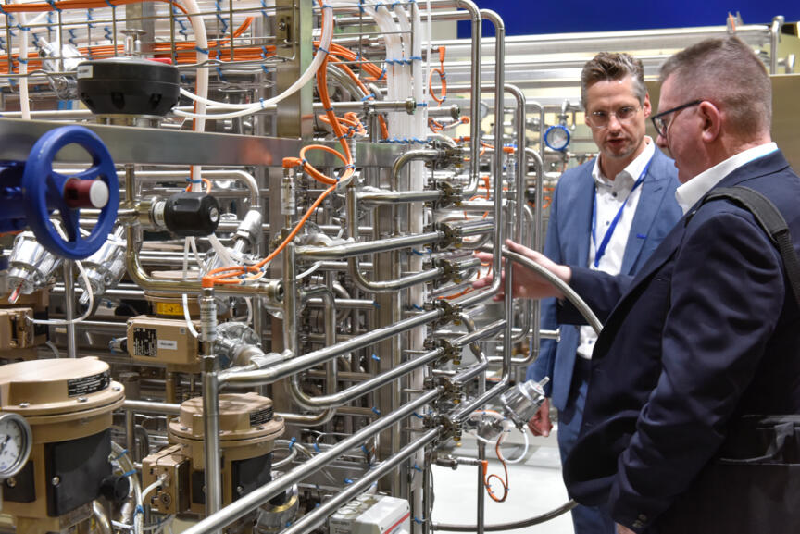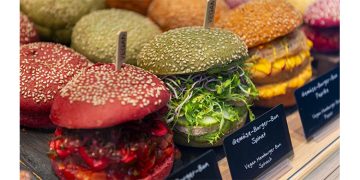The goal of sustainably redesigning the food and beverage industries has never been as urgent as it is today. All the more important is it for producers to efficiently and flexibly use systems that are appropriate for this task. Not least, the consistently high quality of food and food safety is in the focus of developments. “Globally, we are seeing innovations of completely different kinds in process technology. This diversity is also reflected on the Cologne fair grounds at the stands of the exhibitors”, says Matthias Schlüter, Director of Anuga FoodTec. More than a third of the around 1,350 exhibitors from Germany and abroad present solutions in the field of process technology. And these already start with mixing – a complex process that often takes place at the start of production.
Efficient in every production step
Mixers are the workhorses of the food industry and are indispensable for the standardisation of product masses. Where a simple batch mixer was sufficient 15 years ago to process standard recipes with few ingredients, the situation has fundamentally transformed. The market is now more dynamic than ever before. Manufacturers change recipes several times per day in order to adapt their production to the changing wishes of consumers. A modern mixer must be able to master this complexity and be capable of mixing varied raw materials equally wet and dry, and that without making the process more difficult. At Anuga FoodTec, visitors will find a great variety of models that can be adapted to the respective requirements. An example of this are trajectory mixers. They introduce the shear forces by way of the inertia of the mass through the use of programmable trajectories. The highlight: the product found in the process container processes itself gently with itself, entirely without stirring tools.
However, there is more than one process step behind the manufacture of food. The stirrers, kneaders, mixers, extruders, homogenisers and heat exchangers on the Cologne fair grounds are flanked by a large number of digital solutions that are specifically coordinated to the processes and network these to form a complete line. Recipe and batch management software makes it possible to plan and control fully-automated production. Thanks to central terminals, all functions, such as rotational speeds, vacuum values, exposure to gas or the speed of the conveyor systems, can be monitored and operated by one person. User-friendly designs ensure process-safe and intuitive operation and are also a response to the lack of skilled workers in the industry.
Digital and networked along the entire line
The optimisation of production processes occupies a lot of space at Anuga FoodTec. It is primarily the digital technologies that provide insights into the processes that were not so available in the past. Food manufacturers use this as the foundation for elevating their own production to the latest standard and to optimise the harmonisation of human being, machine and processes. With their portfolio, the exhibitors in Cologne begin at precisely this point – for example, with intelligent sensor and web-based process control systems that can also be retrofitted on existing systems. They enable comprehensive sustainability management at the central point of the plant control system.
This enables cross-process automation from the preparation of raw materials with mixing and reduction through processing with portioning, dispensing, molding or extrusion to options like gripping and insertion of the products into the packaging. Intelligent feeds and precise sorting then subsequently ensure that the products are finally packaged and ready for shipping. With such an integrated complete solution, the individual product components for ready-made meals pass without interruption through the weighing and filling stations and are subsequently filled cleanly into bowls and sealed.
Gentle processing for higher quality
Food manufacturers face not only the challenge of continually improving the efficiency of their processes. They must at the same time ensure the durability and the quality of their products. Against this background, non-thermal preservation processes remain the trend. The solutions to be found in Cologne are bundled under the term “Minimal Processing”. These include, for example, high pressure processing (HPP). This enables the gentle preservation of food at 6,000 bar, without heat or additives. The products are treated directly in the final packaging. Because high temperatures are unnecessary, the products remain fresh and of a high quality. That works as well for vacuum and modified atmosphere packaging (MAP) as it does with PET bottles.
New application areas in food processing are also always arising for pulsed electric fields (PEF). The technology is primarily used to date with vegetables and fruit. When producing French fries, PEF pretreatment has become the standard in the meantime. It results in a better cut appearance, reduced loss of raw material and starch losses for manufacturers. The process can be combined with conventional drying methods like hot air, freeze, vacuum, microwave or infrared drying and increases the attractiveness of the dried products – with reduced consumption of water and energy. The technology has recently promised great potential for the manufacture of wine or native olive oil. The principle of electroporation and the resulting discharge of cell sap is applied here to extract valuable ingredients.
The future of food production
From 19 to 22 March 2024, Anuga FoodTec will show what levers food producers can apply to elevate their production processes to the next level of resource efficiency and product quality. The exhibition programme will be complemented by conferences with prominent guests, interactive forums, panel discussions and lectures, special events, guided tours as well as the presentation of the International FoodTec Award 2024. The Main Stage Responsibility (Hall 9, B080/C081) and the Innovation Stage (Hall 5.2, C100/D119) revolve around themes like automation, digitalisation, robotics, sustainability and process optimisation. “This overarching perspective of Anuga FoodTec on developments of the industry thereby helps with reaching investment decisions for new technologies”, according to Matthias Schlüter. The Best Practice technologies shown at the trade fair offer trade visitors valuable stimuli in this regard.

















